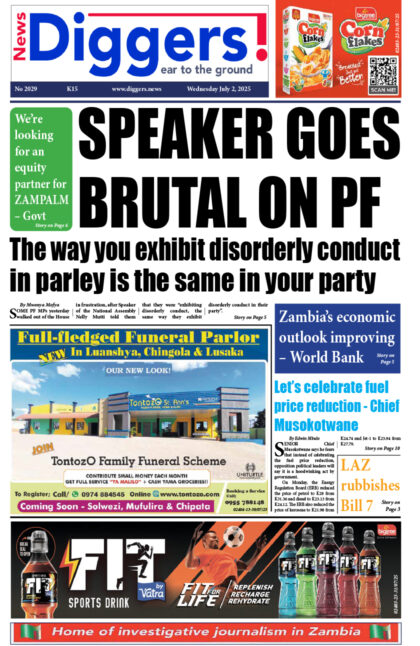Zambia Railways Limited has remained loss-making for three consecutive financial years between the period 2015-2017, with the highest amount being over K134 million in its 2016 financial year.
And Zambia Railways has failed to achieve any its six goals as contained in the company’s Strategic Business Plan (SBP) originally launched in 2013 to encompass a five-year period between 2014-2018.
Meanwhile, the struggling parastatal continues to suffer from “over-aged” locomotives and poor state of infrastructure despite being in receipt of a lucrative US $120 million proceeds from the first Eurobond issued in 2012.
According to Report of the Auditor General on the Accounts of Parastatal Bodies and other statutory institutions for the financial year ended December 31, 2017, Zambia Railways has incurred three successive losses in the period under review, with the highest being over K134 million in its 2016 financial year ending December 31.
Data from the AG’s report revealed that the firm’s losses after tax leaped from incurring a mere K1,418,000 in 2015 to K134,770,000 the following financial year, mainly driven by the company’s escalating administrative expenses and manpower costs.
“Manpower-related costs increased from K151,914,000 in 2015 to K163,345,000 in 2016 representing an increase of 8 per cent. This was evidenced by the increase of employees from 1,118 in 2015 to 1,428 employees as at 31st December, 2018. It was also noted that the manpower costs were more than 50 per cent of the total revenue of the Company. In this regard, the percentage of manpower costs against total revenue increased from 67 per cent in 2015 to 84 per cent in 2016, but reduced to 76 per cent in 2017,” the AG’s Report revealed.
“The manpower costs of the Company was over 50 per cent of total expenditure for the period under review.”
Administrative expenditure also shot up during the period under review.
“The administration expenses increased from K35,750,000 in 2015 to K58,640,000 in 2017 representing a 55 per cent increase. However, the repairs and maintenance costs of property, plant and equipment, which include the railway track and the rolling stock, reduced from K11,817,000 in 2015 to K7,866,000 in 2017 representing a decrease of 33 per cent,” it stated.
The Report, however, noted that there was a minimal reduction in manpower-related costs from K163,345,000 in 2016 to K152,955,00 in 2017, representing a 6 per cent reduction, and consequently leading to reduced losses of K94.3 million in its 2017 financial year.
And Zambia Railways failed to achieve any its six goals as contained in the company’s Strategic Business Plan (SBP) originally launched in 2013 to encompass a five-year period between 2014-2018.
The goals, in order of priority, were to increase train speeds to an average of 70 kilometres per hour from 2015 and achieve at least three per cent on sales as net profit, among others.
“However, these strategies had not been achieved as at 31st December 2018,” the Report disclosed.
Meanwhile, the Report revealed that Zambia Railways continued to suffer from “over-aged” locomotives and a poor state of infrastructure despite being in receipt of a lucrative US $120 million as proceeds from the first Eurobond issued in 2012.
Back then, ZRL staff issued a landmark presentation on: “Track Rehabilitation Using the Eurobond,” where they maintained that train speeds of 70Km and 80Km for freight and passenger trains, respectively, would have been attained by early 2016.
This development was expected to have occurred following completion of full track rehabilitation works, which included insertion of concrete sleepers and welding of rail joints, among others.
But since then, evidence contained in the AG’s Report revealed that the struggling parastatal has outdated, rundown stock.
“A scrutiny of Safety, Health and Environmental Management annual reports revealed the effects of the bad state of Zambia Railways’ infrastructure. In this regard, during the period from 1st January, 2015, to 31st December, 2017, the Company recorded a number of incidents, which included accidents and derailments; the number of derailments increased by 30.86 per cent from 162 in 2016 to 212 in 2017. The number of broken rails increased by 27.56 per cent from 127 in 2016 to 162 in 2017,” it narrated.
“Over-aged locomotives: among the rolling stock of ZRL were the U20C and U15C locomotives, which were over 40 years old.”
Despite rising company expenditure, Zambia Railways was found to have irregularly increased staff salaries.
“Section 102 of the Railways Act states that a railway company shall not exercise any of its powers contained in section 43, 48, 100, and 101 without first obtaining written approval of the Minister. Contrary to the Act, salaries, wages and allowances (housing and productivity allowances) were revised upwards for the financial years ended 31st December, 2016, and 2017 without the prior approval of the Minister,” revealed the AG’s Report.
“Although ZRL had been recovering loans from staff salaries on behalf of financial lending institutions that provided loan facilities to its employees, the Company was not remitting the recovered amounts to the financial institutions. Consequently, as at 31st December, 2018, ZRL was owing various financial lending institutions amounts totalling K3,093,178.”



















